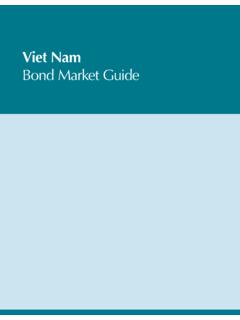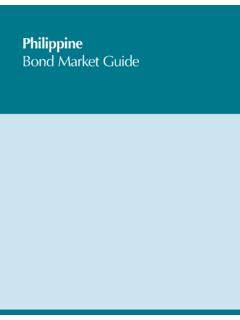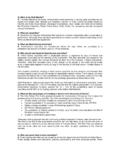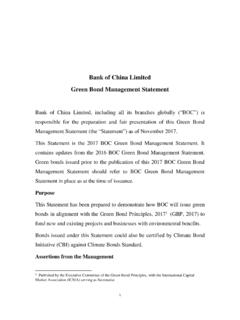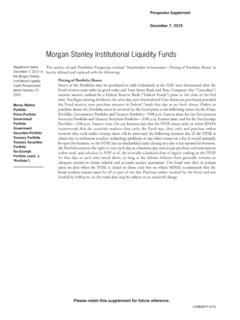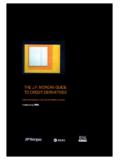Transcription of Introduction - Leveraged Commentary & Data
1 Copyright 2007 Standard & Poor s, a division of The McGraw-Hill Companies, Inc. Introduction High-yield bonds are debt securities issued by corporations with lower-than-investment grade ratings. The issuing companies usually are seeking money for growth (via M&A, perhaps), working capital or other cash flow purposes. The non-investment grade ratings lower than BBB- by Standard & Poor s, Baa3 by Moody s and BBB- by Fitch suggest a higher chance of an issuer default, wherein the company does not pay coupon interest or the principal amount due at maturity in a timely manner. Thus, these companies must offer a higher interest rate and in some cases additional investor-friendly structural features to compensate for bondholder risk, and to attract buying interest. Other terms for high-yield, such as speculative-grade and junk bond , have given the asset class some negative connotation over the years, but high-yield has matured into a solid 20% of the overall corporate bond market, which itself is estimated at roughly $5 trillion, larger than both the Treasury market ($4 trillion outstanding) or the municipal bond market ($2 trillion outstanding), according to bond Market Association estimates.
2 Issuance High-yield bond issuance usually entails three steps: Investment bankers draft the offering proposal and negotiate conditions with potential investors Once terms are finalized, the securities are allocated to bondholders Soon the bonds are available for purchase and sale in the aftermarket, or secondary, via broker/dealers There are a variety of bond structures across the landscape of high-yield, but two characteristics are constant: Coupon, or the rate of interest the entity pays the bondholder annually Maturity, when the full principle amount of the bond issue is due to bondholders Background Corporate bonds have been around for centuries, but growth of the non-investment-grade market did not begin until the 1970s. At this time, the market was composed primarily of companies that had been downgraded for various reasons from investment-grade, becoming fallen angels, and which continued to issue debt securities.
3 The first real boom in the market followed, in the 1980s, however, when Leveraged buyouts and other merger activity appropriated high-yield bonds as a financing mechanism. One famous example is the $31 billion LBO of RJR Nabisco by private equity sponsor Kohlberg Kravis & Roberts in 1989. The financing backing the deal included five high-yield issues that raised $4 billion. Since then, more companies have found acceptance with a growing pool of investors as the high-yield market developed. High-yield bonds still are used to finance merger and acquisition activity, including LBOs, and often back dividend payouts to sponsors, and the market still supports funding capital- intensive projects, such as telecommunications build-out, casino development and energy exploration projects. These days, though, the market also is a good deal of its own refinancing mechanism, with proceeds often paying off older bonds, bank loans and other debt.
4 The high-yield market matured through increasing new bond issuance, which reached peaks of roughly $140 billion issued per year in both 1998 and 2004, and via additional fallen angels, most notably Ford Motor Company and General Motors in 2005. Indeed, with the automakers combined $80 billion of fallen angel corporate bonds entering the market, high-yield has ballooned from around $200 billion in 1995 to roughly $1 trillion in 2006. Steady growth saw only a few notable speed bumps, such as the savings & loan scandal in the 1980s and the correction after the technology bubble burst in 2001. Copyright 2007 Standard & Poor s, a division of The McGraw-Hill Companies, Inc. Standard & Poor s LCD High-Yield bond Marker PrimerPage 2 of 8 The issuers Companies with outstanding high-yield debt cover the full spectrum of industry sectors and categories. There are industrial manufacturers, media firms, energy explorers, homebuilders and even finance companies, to name a few.
5 The one thing in common indeed the only thing is a high debt load, relative to earnings and cash flow (and, thus, the non-investment grade ratings). It s how the issuers got there that breaks the high-yield universe into categories. The first high-yield companies were the fallen angels, or entities that used to carry higher ratings, before falling on hard times. These companies might find liquidity in the high-yield market and improve their balance sheets over time, for an eventual upgrade. Some fallen angels often hover around the high-grade/high-yield border, and frequently carry investment grade ratings by one agency and non-investment grade by another. These often are referred to as split-rated or five-B bonds. Other issuers might never improve, and head further down the scale, toward default and/or bankruptcy. Frequently, high-yield issuers are start-up companies that need seed capital.
6 They do not have an operational history or balance sheet strong enough to achieve investment grade ratings. Investors weigh heavily on the business plan and pro forma financial prospects to evaluate prospects with these scenarios. Telecommunications network builds and casino construction projects are examples. Other capital-intensive businesses, such as oil prospecting, find investors in the high-yield bond market. As well, cyclical businesses, such as chemical producers, use the high-yield market to weather downturns. Leveraged buyouts (LBOs) typically use high-yield bonds as a financing mechanism, and sometimes the private investors will use additional bond placements to fund special dividend payouts. This part of the market saw explosive growth in 2005-06, amid a buyout boom not seen since the late 1980s. Bankruptcy exit financing can be found in the high-yield market.
7 Power producer Mirant is a recent example. The company emerged from Chapter 11 in late 2005 after securing $ billion in exit financing, which included an $850 million issue of bonds due in 2013. The deal was well- received in market despite past investor losses with the credit and the complex restructuring efforts. The investors Investors in high-yield bonds primarily are institutions seeking to earn higher rates of return than their investment-grade corporate, government and cash market counterparts. Other investors include hedge funds, individuals and arrangers of instruments that pool debt securities. Some common investor groups: Mutual funds represent approximately 35% of the investor pool. These institutional investors might be managing traditional, long-only high-yield funds or portfolios that invest only in high-yield securities, but via both long- and short-positions.
8 As well, there are corporate bond funds that invest in both high-yield and high-grade bonds, and general fixed income funds that hold positions across corporate, government and municipal securities segments. Pension funds account for roughly 25% of high-yield investors. They seek greater return on the retirement money entrusted to them than what s being paid out to retirees. Pension funds are trustees for the retirement money and act under prudent investment rules, which vary state to state. Insurance companies invest their own capital and account for around 16% of the high-yield investment community. These accounts cover insurance and annuity products. Collateralized debt obligations, or CDOs, comprise another 16% of the market. These packaged debt instruments invest in a pool of securities for a lower risk of default. Thus, the pool of bonds, or basket of securities, receives higher credit ratings.
9 There are bond -only instruments known as CBOs, loan-only instruments known as CLOs and packages of both, which are generically described as CDOs. Copyright 2007 Standard & Poor s, a division of The McGraw-Hill Companies, Inc. Standard & Poor s LCD High-Yield bond Marker PrimerPage 3 of 8 The balance of the high-yield investment community comprises hedge funds and other specialized investors, as well as a very small amount of individual investors. Hedge funds have had a growing presence in the high-yield market over the 2003-05 bull market. (Source: Merrill Lynch year-end 2004) High-yield bond characteristics As stated, there are many ways a high-yield bond can be structured, but all have two defining traits 1. Coupon 2. Maturity These two characteristics define the value of each bond , and are used as to name the individual security, such as GM s 7% notes due 2012, or even, GM s 7 s of 12.
10 Other characteristics include whether, when and at what price a bond is callable by the issuer, conditions on a put by the bondholder, covenants related to financial performance and disclosure, and even equity warrants. Coupons typically are fixed-rate and pay twice annually. The average coupon for non-investment grade companies have been in the area in recent years, but double-digits are by no means an exception. Some pay no coupon at all. These deals are often called zero-coupon bonds, zeros, or zips, and are sold at a steep discount to face value by companies that might not have the cash flow to pay interest for a number of years. Here, investor return comes in the form of capital appreciation, rather than from interest payments. Zeros were popular with Internet start-ups and wireless build-out projects in the late 1990s. Certain deals are more attractive with a floating-rate coupon. These deals, referred to as floaters or FRNs most often pay interest quarterly, and at a spread priced to the LIBOR rate.

